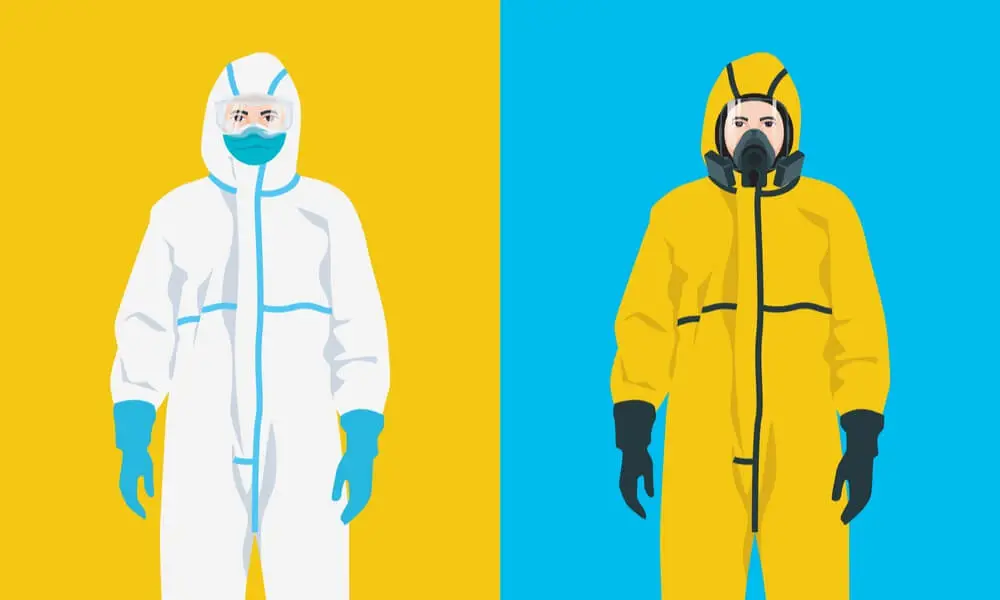So, you’re thinking about giving full body protection a try? That’s a wise decision, my friend! But before you jump right in, let’s talk about what full body protection actually is and when you should consider using it. Full body protection, as the name suggests, is a protective covering that shields your entire body from potential harm or danger.
Whether you’re working in a hazardous environment or participating in high-risk activities, full body protection can provide an extra layer of security and reduce the chances of injuries. But how do you choose the right type of full-body protection? Stay tuned as we explore the factors you should consider when making this crucial decision.
What is Full-body Protection?
Full-body protection refers to the use of personal protective equipment designed to shield and isolate the entire body from exposure to hazards. This type of protection is used in various environments where individuals are exposed to dangerous conditions, harmful substances, or contaminants that can cause injury, illness, or harm. Full-body protection can include items such as coveralls, suits, gloves, boots, goggles, masks, and helmets.
Importance of Full-body Protection
- Prevention of Injuries and Illnesses: Full-body protection is crucial in preventing physical injuries, chemical burns, biological contamination, and other forms of harm, thus ensuring the safety and well-being of individuals in hazardous conditions.
- Compliance with Regulations: In many industries, the use of full-body protection is mandated by law or industry standards to maintain a safe working environment. Compliance with these regulations helps in avoiding legal consequences and maintaining organizational reputation.
- Reduction of Contamination: For professionals working in sterile or clean environments, like healthcare and food processing, full-body protection is essential to prevent contamination and ensure the safety of patients, consumers, and products.
- Protection from Hazardous Substances: Individuals exposed to hazardous chemicals, radiological materials, or biological agents require full-body protection to avoid direct contact with or inhalation of these harmful substances.
- Enhances Worker Confidence: Knowing that they are well-protected can enhance the confidence and morale of workers, allowing them to focus on their tasks without the constant fear of injury or contamination.
- Minimizes Economic Losses: By reducing the risk of injuries and illnesses, full-body protection helps minimize the economic losses associated with medical treatments, compensations, and loss of productivity due to absenteeism.
- Environment-Specific Protection: Full-body protection is tailored to specific environmental hazards, ensuring that individuals have the appropriate level of protection for the risks they encounter, whether it’s extreme temperatures, corrosive chemicals, infectious agents, or physical impacts.
- Emergency Response: In emergency and disaster response scenarios, full-body protection is vital for responders to safely navigate and operate in environments with unknown and potentially life-threatening hazards.
Full-body protection is indispensable in diverse settings, providing a critical barrier between individuals and environmental hazards, and it plays a pivotal role in maintaining the safety, health, and well-being of people in various professions and situations.
The importance of full-body protection extends beyond individual safety, impacting public health, consumer safety, and organizational integrity, emphasizing the need for careful consideration and implementation of appropriate protective measures.

When Should You Use Full Body Protection?
Full-body protection should be used in the following scenarios:
- Chemical Exposure: When working with or around hazardous chemicals that can cause burns, poisoning, or other injuries.
- Biological Hazards: In environments where there is a risk of exposure to infectious agents, such as in medical facilities, laboratories, or during outbreak response.
- Radiological Hazards: When handling or being in the vicinity of radioactive materials, such as in nuclear power plants or during radiological emergency response.
- Physical Hazards: In situations where there is a risk of physical injury from machinery, falling objects, sharp surfaces, or high-impact forces.
- Extreme Temperatures: While working in conditions that involve extreme heat or cold, which could cause thermal burns, frostbite, or hypothermia.
- Contaminated Environments: In settings where soil, dust, or air may be contaminated with toxic substances, such as in hazardous waste cleanup or mining operations.
- Clean Rooms: In environments that require sterility, such as semiconductor manufacturing, pharmaceutical production, or surgical rooms, to prevent product contamination.
- Firefighting and Rescue Operations: During firefighting and emergency rescue operations where, there is a risk of fire, smoke inhalation, or exposure to unknown chemicals.
- Agriculture: When applying pesticides or handling animals that may transmit zoonotic diseases.
- Construction and Manufacturing: Where there is a risk of exposure to asbestos, lead, or other airborne particulates that can cause serious health issues.
- Painting and Coating Operations: When working with paints, coatings, or solvents that emit hazardous fumes or can be absorbed through the skin.
- Law Enforcement and Military Operations: In scenarios that may involve exposure to chemical, biological, radiological, or explosive threats.
Occupational health and safety regulations often mandate the use of full-body protection, and the specific requirements will depend on the nature of the hazard and the level of risk involved. It’s important to conduct a hazard assessment to determine when such protection is necessary and to ensure that the selected PPE is appropriate for the hazards present.

What Should You Consider When Choosing The Type Of Full-Body Protection You Use?
When choosing full-body protection, several factors should be taken into consideration to ensure safety, comfort, and efficiency. Here are some key considerations when selecting full-body protection:
1. Nature And Level Of Hazard
When selecting full-body protection, it’s crucial to understand the nature and level of the hazard involved. For chemical exposure, selecting protection that is resistant to the specific chemicals involved is critical to ensure safety. This can mean choosing materials that do not degrade or permit penetration of the chemical in question.
In situations involving biological hazards, the protection must be able to prevent contamination from bloodborne pathogens or other biological agents, typically requiring a seal or barrier against microscopic organisms.
In cases of radiological exposure, protective garments must be specifically designed to shield the user from radiation, incorporating materials that block or attenuate radiological particles. For physical hazards like impacts, abrasions, and punctures, durable protection that can withstand these forces is essential, which often involves robust materials and reinforced construction.
2. Type Of Work
The type of work being performed significantly influences the choice of protective gear. For manual labour that involves strenuous physical work, lightweight and breathable protection is vital to prevent heat stress and allow for movement and flexibility.
Those in the healthcare field typically require disposable, fluid-resistant protection to prevent the transmission of infectious agents and contamination. Firefighters, on the other hand, need fire-resistant protection that also allows for a high degree of mobility to navigate through challenging environments effectively.
3. Duration Of Exposure
The length of time one is exposed to a hazard affects the suitability of protective gear. Short-term exposure may only require disposable suits that can be removed and discarded after use, reducing the risk of ongoing contamination.
However, for long-term exposure, it is important to have durable and comfortable protection that can withstand extended wear and potential degradation over time without compromising safety.
4. Fit And Comfort
Fit and comfort are paramount when selecting full-body protection. Choosing the correct size is essential for ensuring freedom of movement and preventing restriction during tasks. Breathable materials are important to minimize heat stress, especially when the protective gear is worn for extended periods.
Additionally, evaluating closure types, like zippers or buttons, is vital to ensure they are practical for the work environment and do not compromise the integrity of the protection.
5. Regulatory And Standards Compliance
Compliance with regulatory standards is non-negotiable when choosing protective gear. Protective equipment must meet or exceed the relevant standards and regulations set forth by bodies like OSHA, ANSI, or NFPA to ensure the safety of the wearer. This involves verifying that the gear has been tested and certified for the specific hazards it claims to protect against.
Rigorous testing and certification by recognized bodies ensure that the gear can provide the level of protection required in real-world conditions, reducing the risk to the wearer.

6. Disposable Vs. Reusable
The decision between disposable and reusable protection is critical and depends on the environment and the nature of the hazards involved. Disposable protection is ideal for one-time use in highly infectious or contaminated environments where decontamination is not feasible. It can help in minimizing the risk of cross-contamination.
Conversely, reusable protection is more suitable in scenarios where the protective gear can be adequately cleaned and disinfected after each use, offering a more sustainable and cost-effective solution in the long run.
7. Ease Of Decontamination And Cleaning
When choosing reusable protection, it’s vital to select gear that can be easily decontaminated or cleaned. This ensures the longevity and effectiveness of the gear over time, and it is particularly important in environments where contamination can lead to severe consequences.
The ease of cleaning and decontamination processes is crucial for maintaining a high level of protection and ensuring that no residual contaminants harm the user or others.
8. Cost
Cost is inevitably a factor in choosing protection, but it should never compromise safety. It’s important to thoroughly evaluate the cost against the level of protection, durability, and comfort provided by the gear. A higher initial cost might be justified by increased durability and protection level, potentially leading to lower overall costs when considering replacement frequency and the potential consequences of inadequate protection.
9. Environmental Considerations
Environmental impact is another important consideration, especially when choosing between disposable and reusable protection. Disposable protection, while convenient, generates more waste and can have a greater environmental impact, especially if it contains non-biodegradable materials. Reusable protection can be more environmentally friendly, reducing waste generated over time.
Eco-friendly options that meet protection requirements should be considered to minimize environmental footprint while maintaining safety standards.
10. Specific Requirements
Some work environments have specific requirements that dictate the choice of protection. For instance, in low-light conditions, high-visibility clothing may be required to ensure the safety of the wearer. Waterproof or water-resistant protection may be necessary in wet conditions to maintain the integrity of the gear and protect the wearer from exposure.
Additionally, the protective gear must allow sufficient dexterity to perform tasks effectively, especially in situations where precise movements are crucial.
11. User Training And Education
Proper user training and education are crucial in ensuring the correct use of protective gear. Users should be trained on the correct donning and doffing procedures, limitations of the gear, and proper disposal or cleaning methods. This knowledge is essential for maximizing protection and minimizing the risk of contamination or exposure to hazardous materials.
12. Feedback From Users
Collecting feedback from users is essential for assessing the practicality, comfort, and effectiveness of the protective gear. User experiences can provide invaluable insights into the real-world application of the gear, highlighting any issues or limitations not apparent during the selection process.
This feedback can be instrumental in making informed decisions and adjustments to improve the suitability and performance of the protective gear in specific work environments.

